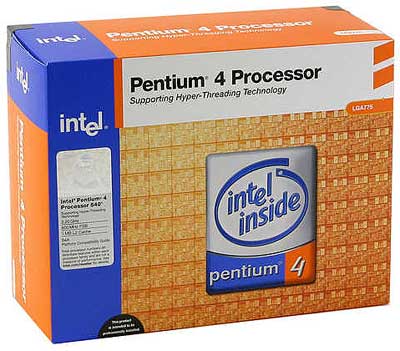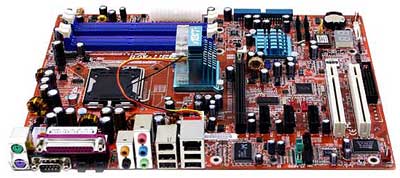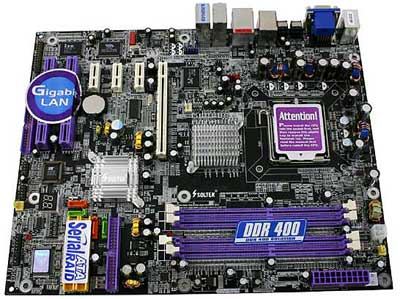Buyer's Guide - Mid-Range, October 2004
by Jarred Walton on October 21, 2004 11:00 AM EST- Posted in
- Guides
Intel CPU and Motherboard Recommendations
"Content Creation", in a generic sense, can still be said to favor Intel CPUs (yes, it is debatable), and so we recommend a Pentium 4 platform for that sort of work. There are also those who will insist on an Intel platform regardless of the overall performance, and we are willing to help them out with some recommendations. Just don't try to make the argument that Intel is more "reliable" as that is difficult to prove. The fact of the matter is that while Intel may not have the best architecture these days, they still have an advantage in other areas such as compiler technology. This can help them to maintain a lead in heavily optimized applications. They also have SSE3 support, which is not yet offered by AMD processors, and HyperThreading can actually help a system to feel more responsive when multitasking.If you're simply going with Intel because that's what you've always used and you assume that they are "better", take a good, long look at the numbers in our recent FX-55/4000+ article. It sums up the situation nicely:
"Closing up our video encoding tests, while AMD does win some, with appropriate optimizations in place Intel seems to be the right candidate here."The same applies for other applications as well: if you're using the latest versions of many professional applications - Photoshop CS, Premier CS, Illustrator CS, 3D Studio Max 7, etc. - you're more likely to benefit from Intel specific optimizations. We mentioned that Intel has better compiler technology than AMD, and that comes into play here. If you depend on an application that has extensive Intel optimizations, then Intel is the right choice. Overall, however, AMD definitely holds the performance crown for the majority of applications.
Then again, we're looking at benchmarks, and benchmarks are rarely the same as real world usage. In the real world, the majority of the CPU processing power is spent waiting for user input - e.g. while you type in Word, or edit an image in Photoshop, or read an article in Firefox. Unless you push your system to the limit on a regular basis, the difference between most of the fastest processors is really quite minor. An exotic car that can run at over 200 MPH is still going to be slow when driving around the neighborhood at 25 MPH. Most people tend to use their computers as commuter cars rather than racing around on the Autobahn. Whatever your reason for opting for an Intel platform, they do provide plenty of performance, and you're not likely to actually notice a difference in typical day-to-day use.

Socket 775 CPU: Pentium 4 540 3.2 GHz 1MB Cache
Price: $216 Shipped (Retail)
Coming with a price similar to the AMD CPUs that we selected, the Pentium 4 540 hits the "sweet spot" for CPU cost in a mid-range system. The Prescott core does run a lot hotter than other CPUs, but the retail HSFs on Intel boxed CPUs are more than capable of cooling the processors. The performance is about the same as the venerable 3.2C socket 478 CPU, which was the speed king and cost well over $400 one year ago, so it's difficult to complain about the bang for the buck. The P4 550 is also an option if you're willing to spend $50 more, but the 560 is simply too expensive for the minor performance increase that it brings over the 540 and 550. You could also opt to save $40 by going with the P4 530, as only those who run benchmarks for a living are likely to notice the loss of 200 MHz. All of the Pentium 4 socket 775 chips that bear the new model numbers come with HyperThreading, and we recommend that you leave it enabled. It may not provide a huge performance increase in typical use, and you might lose a few percentage points in some benchmarks, but it does help performance for other applications if you're running complex tasks in the background, e.g. video/audio encoding or 3D rendering.

Socket 775 Motherboard Recommendation: Abit AG8 i915P Chipset
Price: $129 Shipped
Our recommendation for a Pentium 4 motherboard is also comparable in price and features to the AMD motherboards. It comes with support for up to three Firewire ports, four SATA devices, and eight USB 2.0 devices. It also includes Intel's new High Definition Audio and PCI Express slots. These are all features that are nice to have, and prices have now dropped enough that there is not any real disadvantage in going with the new Intel platform. All of this comes with a motherboard from a manufacturer that is highly respected in the computing industry.
One decision that we made in order to save on costs was to stick with a motherboard that has four DDR1 DIMM slots as opposed to a DDR2 configuration. Our testing to date has not shown any advantage to DDR2 other than lower power consumption, and this is not likely to change until we start seeing Intel systems with the 1066 FSB. Part of the reason for this is that DDR2 simply has worse latencies than DDR1, and there are not many applications that actually require the bandwidth that DDR2-533 and faster RAM can provide. DDR2 RAM also carries a price premium - even the cheapest DDR2 PC4200 will run $250 for 2x512MB, while more expensive DIMMs can push the cost of 2x512MB well over $350. Good quality PC3200 DDR RAM can be had for less money and will typically match or beat the performance of DDR2.

Socket 775 Motherboard IGP Alternative: SOLTEK SL-915GPro-FGR i915G Chipset
Price: $144 Shipped
Users who do not demand a lot from their graphics subsystem might also take a look at some of the motherboards that use the 915G chipset. The latest Intel Graphics Media Accelerator 900 still lags far behind even entry level cards in gaming performance, but for non-gaming use, it is more than enough. It is also almost "free" when you consider the price of the otherwise similar i915P motherboards. The SOLTEK SL-915GPro-FGR that we show here comes with features similar to the Abit AG8 and adds the GMA-900 IGP. If you change your mind and decide that you want to add a PCI Express graphics card in the future, then that option is always there. Users who are not interested in Gaming or other 3D applications will probably never notice the loss of a discreet graphics card.










54 Comments
View All Comments
Avalon - Friday, October 22, 2004 - link
For the s754 system, to clarify. Sorry. Wish these posts could be edited :)Avalon - Friday, October 22, 2004 - link
If you wanted to cut an additional ~$50, switch out that MSI K8N Neo Platinum and throw in an Epox 8KDA3J. It's only $73 on newegg, shipped, which is within a dollar or two of the Chaintech VNF-250, but has loads more features. After all, you guys gave the 8KDA3+ an editor's choice award, so why not recommend the "value" board in a mid range rig? It's an option to ponder over.dragonballgtz - Thursday, October 21, 2004 - link
A $200 CPU would go better with a 9800Pro IMHO for gamers.JarredWalton - Thursday, October 21, 2004 - link
ksherman, that's basically what I went with, but outside of gaming there is no real need for a fast graphics card. $200 for a graphics card that many people do not want/need is difficult to justify. Rather than create more confusion with talk of gaming alternatives, we are going to look at putting together a Gaming Guide in the near future.The Mid-Range PC is such a broad segment that it is virtually impossible to cover all options without writing a 20,000 word article. This one is already long enough, and that was after I removed the gaming options. Here's the basics, though:
If you want a moderate gaming card for AGP, about the only reasonable choice right now is a 9800 Pro. The 6800/6800GT are too expensive for most people, I think. PCI Express has the 6600GT which tends to be faster than the 9800 Pro by about 10 to 20%. As games are GPU limited in most cases, AMD fans will probably either want to wait for PCI Express motherboards and get a 6600GT, or else bite the bullet and spend $360+ on a 6800GT. Ouch. :)
Beenthere - Thursday, October 21, 2004 - link
Nice guide. Lotta work !!!I think the biggest issue for most folks looking to build a new PC or even to upgrade within a budget, is prioritizing. As you can see from the comments above, gamers always want a top-of-the-line Video card even when this takes a big bite outta the budget. To do that you gotta cut cost some place else and that may compromise the total system performance.
Seems to me that an easy means to quantify and qualify the real options for an individual system would be by listing the hardware categories as you've done on a spreadsheet then plug in the hardware and prices accordingly. I think some folks would be surprised to see how their total system price climbs way beyond their original budget when you add $50. here and there to get the "best" of a particular component or to step up to the next level of component.
As you pointed out, sometimes like with memory, buying the lowest latency modules may cost more than moving up 200 MHz in CPU speed, so the CPU may be a better choice. Your guide and recommendations give PC builders a great head start on getting the most bang-for-their-buck.
Thanks for the effort!
ksherman - Thursday, October 21, 2004 - link
also, I think that a good description for a mid range system should be a system with a good amount of power (hence the processor choice) with out the price premium. I like mid-ranges because they offer the power i need with the versitility to do anything I will need to do for a while down the road.ksherman - Thursday, October 21, 2004 - link
It is kinda weird that you recommend such a low-end card for a mid-range system... to me (as everyone else has stated) the 6600 and 9800's should be in the midrange systems. 9600 and similar should be put into low-end systems... in regards to the x300, you state that it is good for those not into gaming so much as other "basic computing tasks", I think that something like that belongs in the low-end systems category.JarredWalton - Thursday, October 21, 2004 - link
I have made a few minor corrections, and I also added a $1000 AMD 754 system to the summary page, for those that might feel $1250 is too much. :)#3: Corrected, thanks. MB, GB... sometimes my fingers have a mind of their own.
#7: RAID 1 hardware controllers should not incur any noticeable performance penalty, as they simply tell both hard drives to write the same data. Better RAID 1 controllers will actually have improved read performance, as they can pull data from two sources. I have not done any extensive testing of this, however, and would guess that most integrated RAID controllers lack that feature. If anyone knows for sure, speak up.
#12: I didn't put much of an emphasis on gaming, as I hope to cover that more in an upcoming Gaming Guide. We'll see if that gets a green light - it's been a while since we covered that topic in depth, I think, although the Doom 3 craze touched on it.
#15: Stay tuned. That's all I will say for now. The Pioneer is still a good choice, though.
#16: Is that typo corrected now? If not, which page are you seeing that on, since I checked both the Display and Summary pages for the error.
Thanks!
Desslok - Thursday, October 21, 2004 - link
That monitor costs as much as the whole system would?NEC/Mitsubishi FE991SB-BK 19" 1274?????
deathwalker - Thursday, October 21, 2004 - link
Great article...I am a little surprised at the Optical Drive choice of the NEC 3500A @ $73, reason being is that you just reviewed the Pioneer 108 and called it the best drive reviewed to date and its only $78.